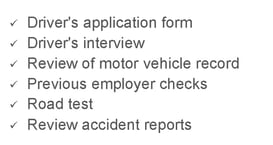

“There! I have a fleet safety program. What more would anyone expect? After all, I’m not in the transportation business….”
It might be natural for business owners whose commercial auto exposure is incidental to their primary business activities to think of these risk control components or tools as all that is necessary to be a good auto risk. But what does this approach to controlling commercial auto exposure really tell us? Does the practice of these activities say this is a superior risk, one deserving of superior insurance placement, products, and pricing? Is this employer truly in control of their exposure? It might be more indicative of an honest attempt to address exposures, but with little enthusiasm, investment, and consequently no expectation of superior results.
Like all safety matters, a superior approach to risk control for fleet exposures will demonstrate a concern for employee and public safety that is engrained in the corporate culture and which is a core value of business’ leaders. As applied to business auto exposure, corporate culture is created by four distinct methods in an organization¹:
1. The actions and behaviors of leaders4. The allocation and attention of resources
Superior commercial auto risks will demonstrate sound risk control principles and practices as core organizational values. Superior leadership demands, cultivates, and models these values to allow them to become cultural within the organization. Business owners who integrate such core values into their corporate culture are well on their way to becoming truly superior commercial auto risks.
¹Pellet, Lizz. “How leaders can impact organizational cultures with their actions and behaviors.” http://www.halogensoftware.com/blog/how-leaders-can-impact-organizational-cultures-with-their-actions-and-behaviors (retrieved June 5, 2017)
²“10 Ways to Create a Safety Culture Among Fleet Drivers.” http://www.automotive-fleet.com/channel/safety-accident-management/article/story/2010/10/safety-10-ways-to-create-a-safety-culture-among-fleet-drivers.aspx (retrieved June 5, 2017)

Robert (Bob) Roe is the Director of Old Republic Risk Management’s loss control function. He is responsible for coordination of policyholder loss control services with an emphasis on carrier service compliance in regulated jurisdictions. Robert is is based out of our corporate office in Brookfield, WI.